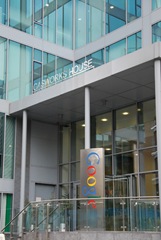Inward investment: the key to recovery
 Economist Alan Gray explains why foreign investment will be the basis for Ireland’s economic recovery and outlines key areas of strength.
Economist Alan Gray explains why foreign investment will be the basis for Ireland’s economic recovery and outlines key areas of strength.
Ireland’s economy faces a critical decade to restore economic growth and to refocus away from the damaging transitory absorption with property. Given the scale of the challenges facing the Irish and European economies and the policy errors made in other areas, Ireland must now build a sustainable platform for growth.
Despite the dramatic post-crisis developments in the Irish economy, which have seen an escalation in Irish public debt and the related collapse in consumer demand and rising unemployment, the factors which enabled Ireland to secure an exceptionally high level of inward investment are all still in place. Returning the economy to modest growth will be possible if we build on Ireland’s unique attractiveness for indigenous and foreign investment, focused on international markets. Indeed Ireland’s position has improved as the post-crisis Irish economy has seen a dramatic reduction in property and housing costs as well as reductions in energy and labour costs and a greater availability of skills.
Mobile investment
All of this makes Ireland more, rather than less desirable as a location for foreign firms. As a result, the small Irish economy has increased its share of US investment to Europe from 5.9 per cent in 2000 to an impressive 9.8 per cent in 2009.
Ireland’s success in attracting mobile investment was the basis for the start of the so-called Celtic Tiger economy, before Ireland became absorbed in a spurious acceleration of growth based on a property bubble. Throughout the period, an expanding and highly skilled internationally traded sector, based in part on foreign investment, has continued to perform strongly. There have also been impressive performances by some Irish companies selling on world markets.
The mistakes which weakened Ireland when faced with an international crisis have understandably damaged the reputation of the country. However, the significant comparative advantages of Ireland as a location for investment remain intact. This helps explain the mystery of how Ireland has managed to continue to expand exports even in one of the worst international recessions in decades. Ireland has also increased its stock of US foreign direct investment to a remarkable $165 billion.
Ireland’s attractiveness
How is it that Ireland continues to be the premier European host to inward investment?
Part of the explanation for Ireland’s continuing success in foreign investment is that Ireland was the first European country to prioritise the attraction of mobile investment. Since TK Whitaker’s time, Ireland has had an active policy of welcoming inward investment. To paraphrase the words of Professor Dermot McAleese, Ireland’s approach to foreign investment involved an early embracing of a policy of red carpet rather than red tape.
For over fifty years, while other countries were attempting to restrict foreign investment, Ireland not only provided these businesses with the freedom to locate, but also removed bureaucracy and rolled out the red carpet to such projects. As a result, multi-nationals based in Ireland represent a roll call of the most successful businesses such as Microsoft, Intel, IBM, Hewlett Packard, Apple, Google, Yahoo, facebook, Pfizer and other market leaders. This gave Ireland early mover advantages which it has built on ever since.
Also of significance is the English language. One of Ireland’s distinctive characteristics is that it is one of only two countries in Europe with this advantage. This is estimated to be equivalent to a tax cost benefit of around 7 per cent. The English language incidentally means that Ireland gets a disproportionate level of praise when its economy is doing well and a lot of attention when it is doing badly.
Ireland’s 12.5 per cent corporate tax rate is also widely recognised as a major advantage combined with the fact it has low corporate taxes rather than being a tax haven destination. New estimates indicate that because of the tax rate, the cost of capital for multinationals investing in Ireland is among the lowest in the OECD but there are other low tax locations in Europe including Switzerland.
There has recently been extensive media discussion that Ireland’s low tax rate could be threatened as a result of the IMF-EU bailout but this is not the case and was never likely. This is because Ireland is too small to matter in revenue terms and also because corporate tax is enshrined in EU legislation as a matter for national governments. Because of its significance to Ireland, maintaining a low corporate tax rate is essential to the country’s recovery, something which is not lost on those countries funding Ireland’s bail-out.
 The two other factors explaining the exceptional strengths of Ireland for investment are its education and skills and the ease of doing business. Ireland’s membership of the European Union provides access to over 501 million people, the largest skilled labour force in the world. This has been reinforced by an exceptionally high level of university attainment in Ireland. Ireland now has one of the highest percentages of the population aged 25-34 with third level education at 44.8 per cent. This compares to only 25.6 per cent in the developed German economy, and in many EU countries the percentage is significantly less. Appropriate graduate education has a special role in the comparative advantages for certain high skilled industry sectors and Ireland’s strengths in this should not be underestimated.
The two other factors explaining the exceptional strengths of Ireland for investment are its education and skills and the ease of doing business. Ireland’s membership of the European Union provides access to over 501 million people, the largest skilled labour force in the world. This has been reinforced by an exceptionally high level of university attainment in Ireland. Ireland now has one of the highest percentages of the population aged 25-34 with third level education at 44.8 per cent. This compares to only 25.6 per cent in the developed German economy, and in many EU countries the percentage is significantly less. Appropriate graduate education has a special role in the comparative advantages for certain high skilled industry sectors and Ireland’s strengths in this should not be underestimated.
The creativity and imagination of Irish people is an important element of human capital. Creativity must influence the ability of any given labour force to produce alternative levels of output and in some sectors this may be the most important factor.
Ireland is also a good country in which to do business and, of 183 countries examined, Ireland is the seventh best country in the world in terms of ease of doing business. Ireland is rated as the best location in Europe in terms of ease of doing business and this helps companies maintain profitability. The significant fiscal adjustments which are being made in the public finances, combined with the reductions implemented over the past three years, will reduce the deficit to sustainable levels and this will improve confidence in the economy, although there is a long and difficult journey ahead. Elements of Irish costs have moved out of line with competitor countries and while widespread reductions have recently taken place, ongoing adjustments are needed.
Policy implications
Foreign direct investment is a key element of the Irish economy and Ireland’s success in continuing to attract foreign investment will be an important determinant of the overall growth in the Irish economy. The significance of foreign direct investment to the Irish economy suggests that the new Government should ensure that the country’s unique advantages for foreign investment are developed while also providing the conditions for the return to growth in indigenous firms.
Ire
land’s prospects for foreign investment are good if the cost adjustments and upgrading of skills and infrastructure in Ireland continues. However, the danger of complacency remains and Ireland needs to constantly evaluate its strengths and weaknesses for foreign investment against its competitors and to build on its strengths and address any deficiencies. In the terminology used in a different context by Coolahan, there is a need to ensure an absence of a “resting on the oars” mentality.
The comparative advantages which have resulted in one of the highest per capita levels of foreign investment in the world are still in place in Ireland and, with appropriate policy responses, Ireland is likely to remain the premier European host for high-skilled investment.
|
Ireland’s share of stock of US foreign investment in Europe ($ million) |
|||||
|
2000 |
2002 |
2004 |
2006 |
2008 |
2009 |
|
5.9% |
6.8% |
7.1% |
6.9% |
9.0% |
9.8% |





